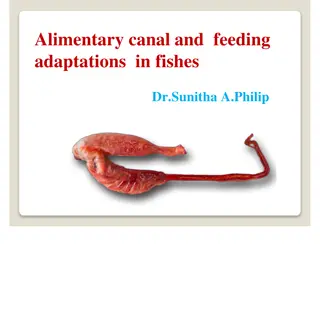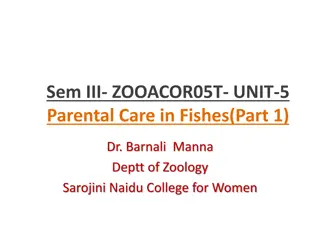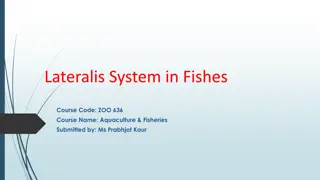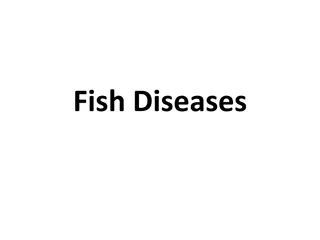Understanding the Positive and Negative Aspects of Fishes
Dr. Mohammad Hamed Bahnasawy, a Professor of fish biology, discusses the positive aspects like diversity and importance of fishes, alongside the negative aspects such as poisonous and venomous fishes, highlighting toxins present in different fish species and risks associated with consumption.
Download Presentation

Please find below an Image/Link to download the presentation.
The content on the website is provided AS IS for your information and personal use only. It may not be sold, licensed, or shared on other websites without obtaining consent from the author. Download presentation by click this link. If you encounter any issues during the download, it is possible that the publisher has removed the file from their server.
E N D
Presentation Transcript
The positive and negative aspects of fishes Prof. Dr. Mohammad Hamed Bahnasawy Prof. of fish biology Zoology Department Faculty of Science Damietta University
The negative aspects 1- Poisonous and venomous fishes A creature is considered poisonous if it contains toxins stored in special tissues or organs that cause harm when eaten. A creature is considered venomous if there are specialized mechanisms to physically deliver the toxins through bites, spines and stings. For example, a puffer fish is poisonous when eaten but is not venomous in that it does not bite or sting in order to deliver the toxins present in certain organs in its body. By contrast, a stonefish is venomous as it has pressure-sensitive glands and spines that help to deliver its toxins when stepped on.
Poisonous fishes There are many of fish species which are known to be toxic to man. Some can cause illness or death when eaten or come in contact with them. Fish toxin can be divided into the following type: 1. Ichthyotoxin: generally, any poison originating from fishes. 2. Ichthyosarcotoxin: poison found in flesh of fishes, excluding poisons due to bacterial action. 3. Ichthyohemotoxin: poison found in blood of fishes. 4. Ichthyootoxin: poison found only in ova of fishes 5. Ichthyoacanthotoxin: poison secreted at the site of a venom apparatus such as spines, stings, or teeth of fishes. 6. Tetrodotoxin: The poison in viscera of puffer fishes.
Ciguatera: a particular icthyosarcotoxin caused by eating various marine fishes of tropical and subtropical areas. This type of intoxication causes nausea, vomiting, abdominal pain, reversal of hot and cold sensation. Various other symptoms may include headache, muscular ashes, dizziness, and occasionally, blistering and loss of skin on hands and feet. A great variety of tropical marine fishes cause this type of poisoning, although some species may be toxic in some geographical areas and not in others. Usually large individuals of a species are poisonous whereas small ones are not. The toxin appears to be obtained through the food chain, originating in marine algae of the genus Diplopsalis, which grows on detritus and plants around coral reefs. The plant is eaten by herbivorous fishes that then become the food of carnivores.
Large carnivores tend to concentrate the poison to the point that they become dangerous to eat. Fishes most often implicated in ciguatera are morays, barracuda, snappers, groupers and jacks. All these fishes are excellent food which is habitually eaten in tropical areas. A few fishes are known to produce toxins from skin glands not associated with any kind of a stinging structure. These poisons called ichthyocrinotoxin, are harmful if ingested by man. Fishes known to have poisonous skin or slime or to secrete toxins upon being disturbed include hagfishes, lampreys, morays, soapfishes, puffers and their near relatives.
Lampreys and hagfishes have been implicated in what is called cyclostome poisoning, and several families of sharks have toxic livers or flesh. The flesh of the Greenland shark Somniosus macrocephalus often contain a toxin that can be removed by drying or thoroughly washing strips of the meat.
Flesh of tunas and their relatives, when improperly stored, can become toxic owing to the presence of histamines and histamine salts. Tunas and swordfishes are known to concentrate mercury through the food chain so that unacceptable levels have been noted.
The puffer poisoning (tetrodotoxism) is caused by eating the viscera of various tetraodontiform fishes, which are common table fare in Japan. The toxin, tetrodotoxin, is particularly strong, and the fatality rate is usually over 50% of those intoxicated. The ovary and liver are the most toxic parts of the fish. The stomach, the intestine, the eyes and kidneys are toxic as well.
Venomous fish A number of fish families contain species capable of inflicting painful stings that combine mechanical injury with release of venom.
Stingrays have spines which are usually situated close to the thick, muscular base of the tail. When the ray is stimulated to defend itself, the tail is curled quickly over the back and the spines thrust at the offender. The wounds resulting from these stings are dangerous and painful. The victim is usually in danger from secondary infections, tetanus, and gangrene, as well as the effects of the venom.
The dogfish shark (Squalus) has the venom glands along the dorsal spines. The venom of sharks is not as dangerous as that of stingrays.
Catfishes have venom glands in the skin sheathing the dorsal and pectoral spines. Most catfish stings are painful but not dangerous, but some species cause edematous swelling and gangrene at the wound.
Scorpion fish (family: Scorpaenidae) are widespread along tropical and temperate shores. Members of this family generally have venom glands in grooves along the dorsal, anal, and pelvic spines.
Stonefishes (family:Synanceidae) have very large venom glands associated with the dorsal, anal and pelvic spines. The ducts of the spines run in a groove to a point near the tip of the spine. The venom is extremely dangerous. There are records of several deaths caused by stonefishes. Members of the family live in the warm Indo-Pacific region.
Dangerous fishes Among the fishes that are injurious to man are electrogenic species such as Torpedo, Electrophorus, and Malapterurus. These can all cause pain and temporary numbness, and the electric eels produce the most powerful shocks of any fish. They can shock prey with up to 600 volts of electricity, enough to hurt even a human .
The candiru is a tiny South American catfish that parasitizes larger fishes, living in their gill cavities. It is apparently attracted to urine and is known to enter the urethra of humans. Surgery is required to remove it because of its recurved spines.
Needlefishes (F. Belonidae) can leap out of the water at great speed, their sharp-pointed beaks and arrow-shaped bodies combining to make them dangerous projections. They occasionally strike boaters, swimmers, or surfboard riders and cause serious effects.
Sawfishes inhabit shallow water and habitually enter tropical or subtropical rivers. They come in contact with bathers or fishermen causing serious injuries and some deaths. A sawfish 4 or 5 meters long blundering into a crowd of bathers and turning swiftly is certain to do damage.
Coral-eating parrot fishes can deliver painful or injurious bites when mishandled after capture The deep-set, Knife like teeth of the barracuda are capable of tearing out great chunks of flesh
Sharks, of course, are the fishes that draw most attention as man- eaters. Some are of large size and have voracious appetites, seeking large prey. These apparently attack man as a source of food
Fish as carriers of parasites and diseases Various fish species have the ability to harbor parasites that can affect man directly. The parasites are usually of concern only in areas where freshwater fishes are eaten raw or without sufficient processing, although there are some parasites that can be transmitted to man by marine fishes. Most of the parasites involved are worms, nematodes, cestodes and trematodes. One potentially dangerous nematodes is the kidney worm, Dioctophyma renale, which is known mainly from the orient.
Positive aspects of fishes 1- Fishes as biological control agents The varied feeding habits of fishes sometimes lead to the use of certain kinds of fishes to control organisms considered undesirable. Some fish of family Poeciliidae especially Gambusia is the best known of the insect-controlling species, therefore they are called mosquito fish. They are found in some areas like Mississippi and adjacent drainages. Its reputation as a mosquito eater stimulates many countries to use these species for this purpose. There are several fishes that feed upon freshwater snails, which form the intermediate host of parasites of man (e.g. Schistosoma). Of special note are certain African cichlids and the black or mud carp of Asia.
The grass carp (Ctenopharyngodon idella) are used for aquatic weed control which causes many problems in aquatic canals. These fishes feed almost exclusively on aquatic plants, ingesting huge amount daily. Although only a portion is digested, the vegetation is shredded by the carp's pharyngeal teeth and passed through the alimentary canal, becoming, in effect, a fertilizer for other plant growth. The grass carp is an excellent table fish, and has been introduced to many countries, where it serves double duty as a food fish and an aquatic weed control agent.
2- Scientific uses of fishes Fishes are excellent subjects for the study and demonstration of anatomy, physiology, ecology, evolution, and other aspects of science. The dogfish (Squalus acanthias) and Tilapia species have become standard dissection laboratory animals because of their ready availability and their representation of typical structure of lower vertebrates. Many fish species are used in studies of water pollution and the effect of various pesticides and waste products on aquatic life. The hagfishes, with their extra hearts, have aided physiologists in studies of cardiac pacemaker cells.
3- Fishes as item of commerce From the economic point of view, fishes have a commercial importance, where they are used in many industries like canning, salting, and smoking. Fishes are used also in manufacturing of glue, as a source of leather, as a source of silver pigment (guanine) for certain paints. Fish oil is another fish product which is used in many industrial and medical purposes. In addition to this, Fish are used in production of fish meal, mainly for agriculture. Protein-rich fish meal is a basic ingredient in the food of poultry, fishes and other domestic animals. Fish is consumed as a food by many species, including humans. It has been an important source of protein and other nutrients for humans throughout recorded history. Fish provides a good source of high quality protein and contains many vitamins and minerals.
4- Recreational fisheries (R F) Recreational fisheries can be defined as non-commercial subset of capture/harvest fisheries, motivated by catching fish for fun, pleasure, or sport. Recreational fisheries can be defined also as all types of fishing activities including sport fishing activities undertaken by any individual, with or without a boat, for leisure purposes, and does not involve the selling of fish or other aquatic organisms. R F is called also sport fishing, is fishing for pleasure or competition. It can be contrasted with commercial fishing, which is fishing for profit, or subsistence fishing, which is fishing for survival. The most common form of recreational fishing is done with a rod, reel, line, hooks and any one of a wide range of baits.
In Egypt, recreational fisheries is a traditional pastime, particularly in the coastal large cities of Alexandria, Damietta, PortSaid , AlAresh and Red Sea. The common recreational fisheries-targeted species in Egypt are Groupers, KawaKawa, Chub mackerel, gurnard, sea bass, gilthead seabream, blue fish. Recreational fisheries exist in developed countries as a pastime and in underdeveloped countries as a tourist attraction. Besides being an excellent use of leisure time, angling promotes a great circulation of money. Anglers purchase such items as fishing tackle, boats, outboard motors and camping gear. They expend money for travel, food.























